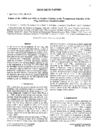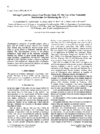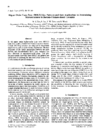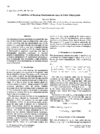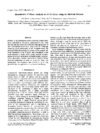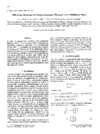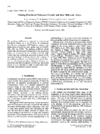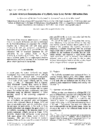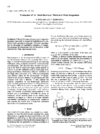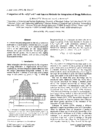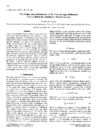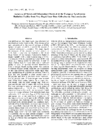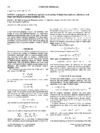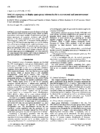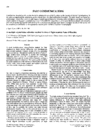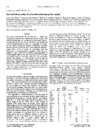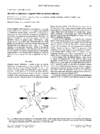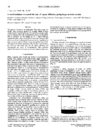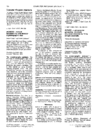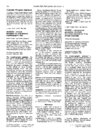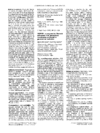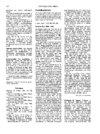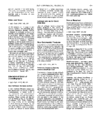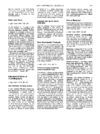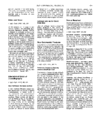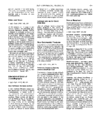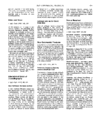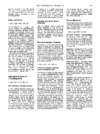issue contents
April 1997 issue

Cover illustration: A crystal of the protein phosphorylase b flash-cooled to 100 K in a 1 mm-diameter mohair loop prior to collection of X-ray diffraction data. Courtesy of Elspeth Garman and Stephen Lee, University of Oxford.
research papers
It has been found that the two positive glitches observed at 1385.6 and 1438 eV in the transmission function of the YB66 double-crystal monochromator are caused by the anomalous increases of the reflective intensity of the 006 reflection at the yttrium LIII and LII absorption edges. The intensities of these two glitches are reduced to minimal values by the installation of an SiC cut-off mirror downstream from the YB66 monochromator.
A probabilistic method is integrated with the Le Bail algorithm to decompose a powder diffraction pattern: it provides more accurate estimates of the structure-factor amplitudes.
In this paper, higher-order Laue Zone (HOLZ) lines in BaTiO3 ceramics are obtained and a tiny difference of the lattice parameters between the pure and Ba(Ti,Sn)O3 ceramics has been observed in nanometre-sized areas.
The theoretical function describing the probability density of disorientation axes is obtained for cubic polycrystals. An analytical expression for this density function is determined in spherical coordinates to facilitate graphical representation.
The application of the Rietveld method to different X-ray powder diffraction spectra allows the determination of the mass fraction evolution and the mean size evolution with aging time at 453 K of the δ' precipitates in an Al–Li alloy.
The microstructure of three-component Fibonacci Ta/Al multilayer films is studied by transmission electron microscopy and electron and X-ray diffraction.
The packing coefficient in orientational disordered phases for a set of series of compounds derived from neopentane and their molecular alloys is reported in order to analyze the molecular interactions.
The results of the structural determination of Li2MnO3 from X-ray powder diffraction data and refinement by the Rietveld technique are presented.
A numerical method for evaluation of the performance of a new peak-integration procedure is presented.
Various peak integration procedures are compared with an idealized least-squares procedure, and it is shown that, in practical conditions, an analytic σ(I)/I procedure comes very close to the ideal.
A neutron beam, reflected by a thin-film multilayer monochromator, will also contain the long-wavelength component of the incident spectrum in addition to the desired band of wavelengths. A number of approaches have been suggested to minimize this contamination.
Line-profile simulation and matching on the basis of a paracrystalline one-dimensional Hosemann's model provides a promising approach to the analysis of X-ray line broadening and is presented here.
An accurate structural model of native cutinase was derived from Laue data recorded in 8.5 ns at the European Synchrotron Radiation Facility, demonstrating the potential of very rapid Laue data collection for time-resolved studies.
The polarization state of the transmitted beam in Bragg-case X-ray diffraction has been determined.
computer programs
The program DISCUS is a versatile tool for the analysis of diffuse scattering and for defect-structure simulations.
Features of a new program for single-isomorphous-replacement and single-wavelength-anomalous-scattering local scaling are described.
A PC computer program developed to display space-group information is described.
laboratory notes
A perspex box for crystal growth by vapour diffusion has been designed.
fast communications
Download citation


Download citation


The structure of an organic material, acetylcholine bromide, is refined from neutron diffraction data deliberately collected from a multiple-crystal sample. The method developed has clear promise in several areas including allowing more rapid data collections, enabling the use of smaller crystals and studying single-crystal samples in more complex sample environments.
A method for preparing cryocooled xenon-derivatized protein crystals is presented.
It is shown how neutron reflectivity is altered when magnetic field gradients are present along the neutron path.
A simple technique for improving the size of protein crystals by controlling the rate of vapour-diffusion trials is presented.
By comparison of the accuracy and the merging R factor (Rmerge) of artificially created X-ray data sets, it is demonstrated that Rmerge is a poor predictor for the precision of X-ray data. The more often a given reflection is observed, the more precise the average intensity is, whereas Rmerge has a tendency to be higher at higher data redundancy.
computer program abstracts
A program for the manual indexation of area-detector data is presented.
A program that, given the tilt system, tilt angles and octahedral bond distances, will calculate the ideal crystal structure for AMO3 and A2MM'O6 perovskites distorted by octahedral tilting is presented.
See the Journal of Applied Crystallography Software List 1997.
DEBVIN is a program that combines the Rietveld approach with the use of generalized coordinates. It is a particularly useful tool when, as in polymer crystallography, structures are rather complex and diffraction patterns highly overlapped and confined to low diffraction angles. Refinement of crystallite dimensions is also a qualifying feature of this program.
See the Journal of Applied Crystallography Software List 1997.
crystallographers
Free 

notes and news
Free 

international union of crystallography
Free 

new commercial products
Free 

books received
Free 

Free 

Free 

Free 



 journal menu
journal menu








